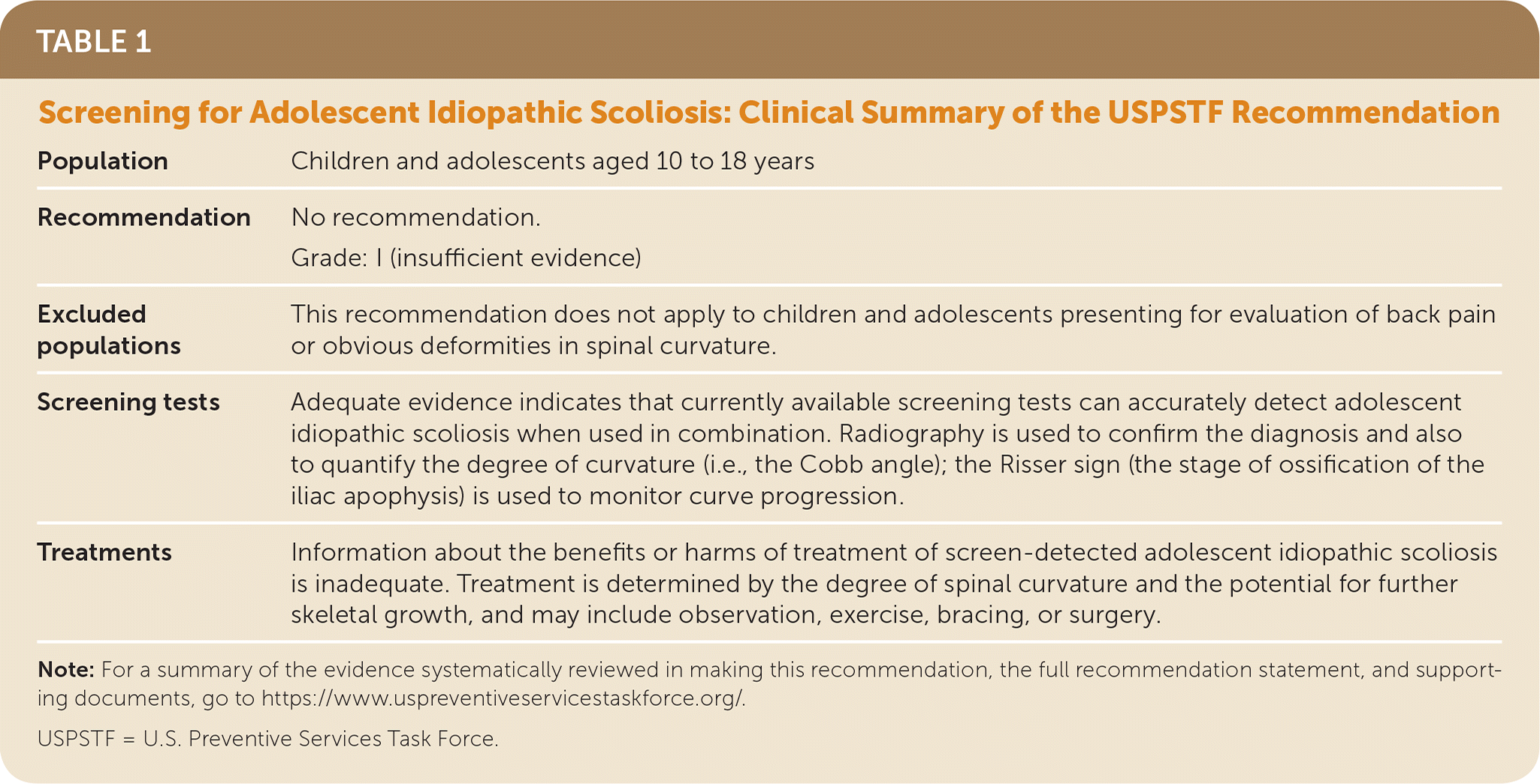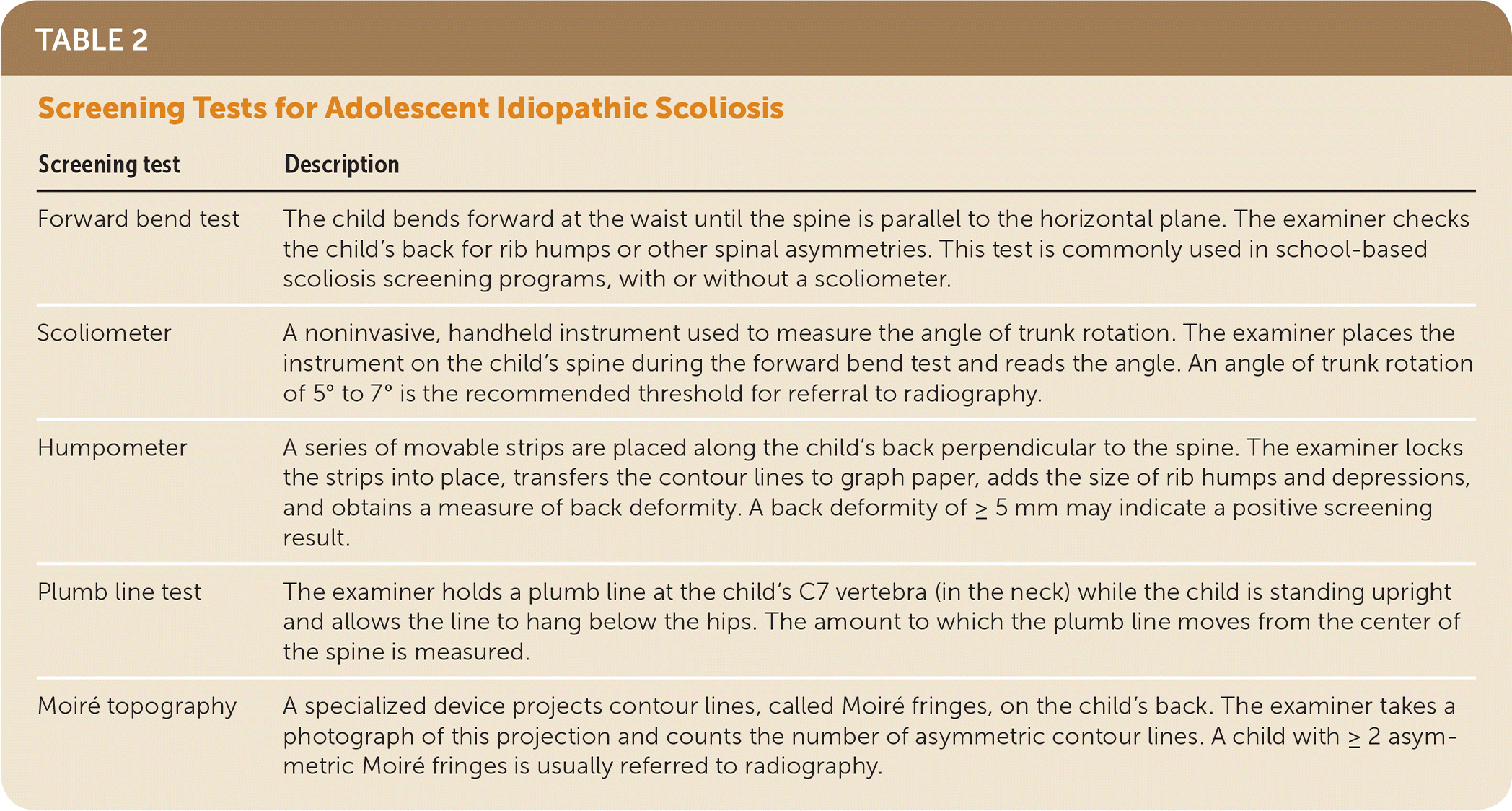
Am Fam Physician. 2018;97(10):online
Related Putting Prevention into Practice: Screening for Adolescent Idiopathic Scoliosis.
Summary of Recommendation and Evidence
The USPSTF concludes that the current evidence is insufficient to assess the balance of benefits and harms of screening for adolescent idiopathic scoliosis in children and adolescents aged 10 to 18 years (Table 1). I statement.

| Population | Children and adolescents aged 10 to 18 years |
| Recommendation | No recommendation. Grade: I (insufficient evidence) |
| Excluded populations | This recommendation does not apply to children and adolescents presenting for evaluation of back pain or obvious deformities in spinal curvature. |
| Screening tests | Adequate evidence indicates that currently available screening tests can accurately detect adolescent idiopathic scoliosis when used in combination. Radiography is used to confirm the diagnosis and also to quantify the degree of curvature (i.e., the Cobb angle); the Risser sign (the stage of ossification of the iliac apophysis) is used to monitor curve progression. |
| Treatments | Information about the benefits or harms of treatment of screen-detected adolescent idiopathic scoliosis is inadequate. Treatment is determined by the degree of spinal curvature and the potential for further skeletal growth, and may include observation, exercise, bracing, or surgery. |
Rationale
IMPORTANCE
Adolescent idiopathic scoliosis is a lateral curvature of the spine of unknown cause with a Cobb angle (a measure of the curvature of the spine) of at least 10° that occurs in children and adolescents aged 10 to 18 years. It is the most common form of scoliosis and usually worsens during adolescence before skeletal maturity. In the United States, the estimated prevalence of adolescent idiopathic scoliosis with a Cobb angle of at least 10° among children and adolescents aged 10 to 16 years is 1% to 3%.1,2 Most patients with a spinal curvature of greater than 40° at skeletal maturity will likely experience curvature progression in adulthood. Severe spinal curvature may be associated with adverse long-term health outcomes (e.g., pulmonary disorders, disability, back pain, psychological effects, cosmetic issues, and reduced quality of life).1,3 Therefore, early identification and effective treatment of mild scoliosis could slow or stop curvature progression before skeletal maturity, thereby improving long-term outcomes in adulthood.
DETECTION
The USPSTF found adequate evidence that currently available screening tests can accurately detect adolescent idiopathic scoliosis. The accuracy of screening was highest (93.8% sensitivity and 99.2% specificity) when 3 separate screening tests were used (e.g., the forward bend test, scoliometer measurement, and Moiré topography); sensitivity was lower when screening programs used just 1 or 2 screening tests (e.g., 71.1% for the forward bend test and scoliometer measurement and 84.4% for the forward bend test alone).
BENEFITS OF EARLY DETECTION AND INTERVENTION OR TREATMENT
The USPSTF found no direct evidence regarding the effect of screening for adolescent idiopathic scoliosis on patient-centered health outcomes. The USPSTF found inadequate evidence on the treatment of idiopathic scoliosis (Cobb angle < 50° at diagnosis) in adolescents with exercise (2 small studies) or surgery (no studies) or its effects on health outcomes or the degree of spinal curvature in childhood or adulthood. The USPSTF found adequate evidence (5 studies) that treatment with bracing may decrease curvature progression in adolescents with mild or moderate curvature severity (an intermediate outcome). However, it found inadequate evidence on the association between reduction in spinal curvature in adolescence and long-term health outcomes in adulthood.
HARMS OF EARLY DETECTION AND INTERVENTION OR TREATMENT
The USPSTF found no studies on the direct harms of screening, such as psychological harms or harms associated with confirmatory radiography. The USPSTF found inadequate evidence to determine the harms of treatment.
USPSTF ASSESSMENT
The USPSTF concludes that the current evidence is insufficient and that the balance of benefits and harms of screening for adolescent idiopathic scoliosis cannot be determined.
Clinical Considerations
PATIENT POPULATION UNDER CONSIDERATION
This recommendation applies to asymptomatic children and adolescents aged 10 to 18 years. This recommendation does not apply to children and adolescents presenting for evaluation of back pain, breathing difficulties, abnormal radiography findings or other imaging studies, or obvious deformities in spinal curvature.
SCREENING TESTS
Most screening tests for adolescent idiopathic scoliosis are noninvasive. Screening is usually done by visual inspection of the spine to look for asymmetry of the shoulders, shoulder blades, and hips. In the United States, the forward bend test is commonly used to screen for idiopathic scoliosis. First, a clinician visually inspects the spine of a patient while the patient is standing upright. Next, the patient stands with feet together and bends forward at the waist with arms hanging and palms touching. The clinician repeats the visual inspection of the spine.1,4 A scoliometer, which measures the angle of trunk rotation, may be used during the forward bend test. An angle of trunk rotation of 5° to 7° is often the threshold for referral for radiography.1 Other screening tests include a humpometer, the plumb line test, and Moiré topography (creating a 3-dimensional image of the surface of a patient's back) (Table 2).

| Screening test | Description |
|---|---|
| Forward bend test | The child bends forward at the waist until the spine is parallel to the horizontal plane. The examiner checks the child's back for rib humps or other spinal asymmetries. This test is commonly used in school-based scoliosis screening programs, with or without a scoliometer. |
| Scoliometer | A noninvasive, handheld instrument used to measure the angle of trunk rotation. The examiner places the instrument on the child's spine during the forward bend test and reads the angle. An angle of trunk rotation of 5° to 7° is the recommended threshold for referral to radiography. |
| Humpometer | A series of movable strips are placed along the child's back perpendicular to the spine. The examiner locks the strips into place, transfers the contour lines to graph paper, adds the size of rib humps and depressions, and obtains a measure of back deformity. A back deformity of ≥ 5 mm may indicate a positive screening result. |
| Plumb line test | The examiner holds a plumb line at the child's C7 vertebra (in the neck) while the child is standing upright and allows the line to hang below the hips. The amount to which the plumb line moves from the center of the spine is measured. |
| Moiré topography | A specialized device projects contour lines, called Moiré fringes, on the child's back. The examiner takes a photograph of this projection and counts the number of asymmetric contour lines. A child with ≥ 2 asymmetric Moiré fringes is usually referred to radiography. |
If idiopathic scoliosis is suspected, radiography is used to confirm the diagnosis and to quantify the degree of curvature (i.e., the Cobb angle) and the Risser sign (the stage of ossification of the iliac apophysis).1 U.S. organizations that advocate screening recommend the forward bend test combined with scoliometer measurement.
TREATMENT
The goal of treatment is to decrease or stop progression of spinal curvature during the period of adolescent growth prior to skeletal maturity. Treatment of adolescent idiopathic scoliosis is determined by the degree of spinal curvature and the potential for further growth and generally includes observation, bracing, surgery, and exercise.1
SUGGESTIONS FOR PRACTICE REGARDING THE I STATEMENT
Potential Preventable Burden. Most children and adolescents with scoliosis do not have symptoms. Generally, smaller spinal curvatures remain stable, while larger curvatures tend to progress in severity.
Pulmonary dysfunction can be clinically significant in patients with spinal curvatures greater than 100°; however, curvatures of that severity are rare. Back pain is more common, but its effect on functioning or disability is unclear.1 Current evidence suggests that the presence of back pain does not necessarily correlate with the degree of spinal curvature in adulthood. Adults with adolescent idiopathic scoliosis may have poor self-reported health, appearance, and social interactions. Mortality is similar to that among unaffected adults.1
Potential Harms. Evidence on the harms of screening for adolescent idiopathic scoliosis is limited. False-positive results are an important potential harm, with rates ranging from 0.8% to 21.5%.1,5,6 However, the direct harms of screening are unclear. Potential harms of false-positive results include unnecessary follow-up visits, increased cancer risk attributable to radiation exposure, overtreatment, or psychosocial effects associated with the diagnosis of clinically nonsignificant scoliosis.1
Current Practice. Various organizations have recommended routine screening for scoliosis in children and adolescents since the 1980s.1,4 More than half of U.S. states either mandate or recommend school-based screening for scoliosis.1,4,7 Children and adolescents are usually screened with the forward bend test, with or without scoliometer measurement.1,4
In general, patients with a Cobb angle of less than 20° are observed without treatment; however, exercise may be recommended at this time. Patients with a Cobb angle greater than 30° or a Cobb angle of 20° to 30° that progresses 5° or more over 3 to 6 months are treated with bracing. Patients with a Cobb angle of 40° to 50° may be treated with bracing or surgery, while those with a Cobb angle greater than 50° typically require surgery.1
